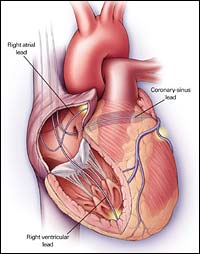 Heart failure due to a weak heart can not only significantly compromise a patient’s quality of life due to shortness of breath, leg swelling and fatigue, it can also markedly increase the risk for death. When the heart becomes weak and dilated, it takes longer for the electrical stimulus to reach different parts of the heart and cause an already weakened heart to contract in an abnormal, uncoordinated fashion. A biventricular pacemaker can help certain patients by allowing the heart to contract more efficiently thereby reducing shortness of breath, improving the strength of the heart and reducing the risk for death.
Heart failure due to a weak heart can not only significantly compromise a patient’s quality of life due to shortness of breath, leg swelling and fatigue, it can also markedly increase the risk for death. When the heart becomes weak and dilated, it takes longer for the electrical stimulus to reach different parts of the heart and cause an already weakened heart to contract in an abnormal, uncoordinated fashion. A biventricular pacemaker can help certain patients by allowing the heart to contract more efficiently thereby reducing shortness of breath, improving the strength of the heart and reducing the risk for death.
A normal artificial pacemaker has a wire that typically goes into only one ventricle, the right ventricle. A biventricular pacemaker has an additional wire which paces both the left and right ventricles thereby providing simultaneous contraction of the entire heart and increasing its strength and efficiency. In addition most biventricular pacemakers also have a defibrillator (ICD) function as well.
 Similar to normal pacemakers and defibrillators, biventricular pacemakers are small devices placed under the skin just below the collarbone. Unlike normal pacemakers, biventricular pacemakers are designed to pace the heart nearly all the time. The ICD capability is exactly the same as a stand-alone defibrillator.
Similar to normal pacemakers and defibrillators, biventricular pacemakers are small devices placed under the skin just below the collarbone. Unlike normal pacemakers, biventricular pacemakers are designed to pace the heart nearly all the time. The ICD capability is exactly the same as a stand-alone defibrillator.
The operation is similar to pacemaker and ICD placement with wires placed into the right atrium (one of the upper chambers of the heart) and right ventricle (one of the lower chambers of the heart). In addition another wire is placed into the vein behind the left ventricle, and this can take more time with procedures typically taking 1-2 hours. It is performed under local anesthesia with mild to moderate sedation but not general anesthesia. Similar to an ICD, after the device is placed you will be briefly placed under general anesthesia so that the shocking function can be tested. Typically the only discomfort felt is during the injection of local anesthesia at the start of the procedure. A small incision is made under the clavicle and the wires are placed through the vein below the collarbone into the heart. The small generator is then placed under the skin and attached to the wire. You will spend the night in the hospital after the procedure on a cardiac unit. A chest x-ray will be performed the following day and typically the patient is discharged to follow-up with our Device Clinic as well as with your cardiologist.
In 2007, Merrimack Valley Cardiology became the only cardiology group in the area that specializes in placing and managing these devices. By developing a local electrophysiology program, we are bringing these increasingly common and safe procedures to the community and improve the overall cardiovascular care of our patients.
What to Expect Before the Procedure:
- Nothing to eat after the midnight before the procedure.
- You may take your pills with small sips of water.
- Diabetes pills should be held and if you take insulin, ask your physician how the dose should be adjusted.
- If you take Coumadin, aspirin or Plavix, please ask your cardiologist if these should be withheld before the procedure.
- You may bring a CD of your favorite music to help you relax.
What to Expect After the Procedure:
- There may be soreness at the incision site and possibly some swelling and bruising.
- The dressing should be left in place for 3 days.
- You should not take a shower for at least 3 or 4 days and definitely not bathe or swim for several weeks.
- You should try to limit large motions of the affected arm to avoid pulling out one of the wires before it has fully healed.
- Ask your cardiologist when you can drive.
- Follow up in the Device Clinic will be arranged for approximately one week to check the wound and evaluate the pacemaker and defibrillator function. There will not be any external stitches to remove, although occasionally the cardiologist may use staples which will require removal.
Complications:
Possible complications of the surgery are infection, collapse of a lung, perforation of the heart and excessive bleeding. Your cardiologist is trained in managing these potential complications.
For more information about Defibrillators, click here.
